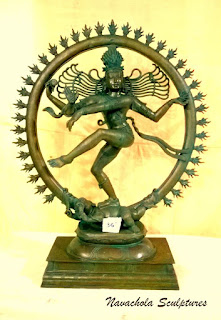 |
| Swamimalai idol of Cosmic dancer God Nataraja. in.pinterest.com |
When it comes to stunning beauty and grandeur of well-crafted bronze images or statues, the Swamimalai artefacts are quite well-known for their craftsmanship. Always in demand because of their workmanship and gold-like metal finish exuding divinity the Panchaloha images are a class apart amd never fail to impart an aura about the place where they stand majestically- be in the place of worship, a showroom or reception room in elegant houses. This amazing ancient craft, exclusive to South india still thrives, thanks to some families of hereditary sthapathis (sculptors) whose sentiments and traditional techniques keep this ancient art intact.
 |
| Swamimalai Kalinga Mardhana Krishna statuetwitter.com |
 |
| Swamimalai Panchaloha idols, Rama, et al. ustdial.com |
 |
| God Vishnu in.pinterest.com |
 |
| Swamimalai idol. Cosmic dancer nataraja. m.indiamart.com |
Above images: The Swamimalai bronze icons were made in India, particularly in Tamil Desam over 1100 years for the main purpose of worship in temples. These icons were patronized during the Chola Dynasty and the reason why historical meaning is attached to them is the sculptors of Swamimalai of TN for centuries have been following the traditional procedures laid down in the Silpa Sastra.Of all the bronze icons the most popular one is that of Nataraja or Adavallar. His cosmic dance (raised left leg in 'bhujanga trasita' stance which represents 'trio bhava) symbolises the transient nature of the universe and the cycles of creation and destruction. He is active, yet aloof, like the gods on the Parthenon Frieze......................
The small town of Swamimalai, close to the temple city of Kumbakonam in Thanjavur District is the hub of various bronze products that highlight the artistic brilliance and cultural heritage. The earliest bronze statues were cast around 2300 BC in the Indus Valley. The town’s association with bronze statues can be traced back to the Chola period, which saw the heyday between the 9th and 13th centuries. During that period this ancient art got a big boost from the rulers who were builders of big temples.
These sthapathis created beautiful statues for Airavatesvara Temple (UNESCO world heritage site), Darasuram, Kumbakonam. Later, they settled down as a community in Swamimalai and since then the Chola bronze statues have been popular and among the finest examples of bronze casting in the world Swamimalai is still renowned for its rich artistic legacy.
The Swamimalai Bronze Statues are not only iconic sculptures of beauty but also symbols of ethos and culture native to this specific region. Some of the families that know the nuances of this ancient art date back to the period of great Rajaraja Chola I who diligently used their skill and commissioned a group of sculptors for the Brihadeeswara Temple at Thanjavur which he had built.
The sthapathis here always stick to the procedures prescribed in the Silpasastra in the making of bronze idols. Two important facts are recitation of a sloka for each deity when making and the right posture. The Silpasastra has laid down norms for idols of various deities and their postures. The most popular statue is that of Nataraja, the cosmic dancer. the procedures need to followed carefully when making dancing Nataraja. In this profession the various delicate intricacies in the craft require skills and dexterity of hands . The craftmen could attain finesse and mastery over years of training.
The sculptors follow the wax casting method involving a clay model, covering it with layers of wax which itself is a mixture of beeswax, resin, and groundnut oil, encasing it in a heat-resistant mold. Then it involves melting of the wax to create a cavity. Molten metal, usually a mixture of copper and tin a bit of gold, is poured into the mold through selected drilled holes, taking the place of the wax. Once the metal solidifies, a few days later the mold is broken open , revealing the exquisite bronze statue within. The emerging image is a rough one and the craftsmen spend a few days to give polishing and final finishing to every part right from the head to toes. The common tools of the sculptor, the hammer and chisel, are used to get rid of the unwanted metal from the casting. Engraving tools, files, and forceps are used to carve the statue further and to turn it into the inspiring beauty it was intended to be.
The town has numerous experienced craftsmen and master craftsmen and they have won awards at the state and national level, too. They receive orders for idols from all over the globe, particularly for the Hindu temples and they take specified time to fill in the orders, depending on the details, size and quality.
Among the sthapathis, mention may be made of S. Devasanapathy who got a covetous national award in 1984 and his sons follow him suit. Being well-versed in Silpasastra, the sculptors from this family are the Asthana Vidwans of Kanchi Kamakoti Mutt. The acharyas honored them on some occasions.
In recognition of their unique, traditional and outstanding art that has been around for centuries, Swamimalai bronze icons were awarded the prestigious Geographical Indication or GI tag in the year 2008-09. One important aspect of Swamimalai Sthapathis is regardless of work, there is no compromise on quality as well as traditional norms as per Silpa sastra.
https://www.deccanherald.com/features/bronzed-beauties-769364.html









